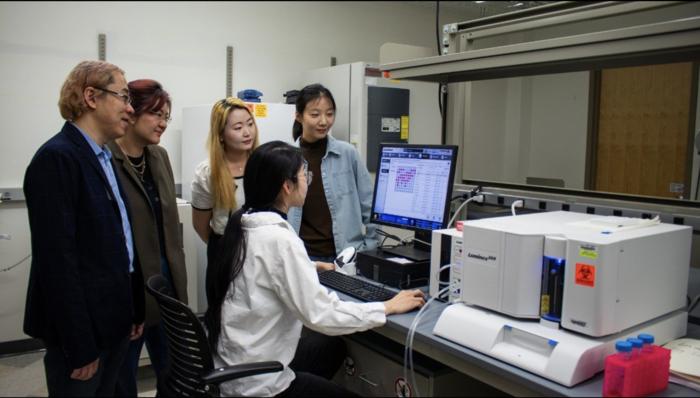
In a groundbreaking leap forward for optoelectronic technology, researchers have unveiled a novel class of phase-pure ferroelectric quantum wells that exhibit exceptionally tunable photoluminescence properties, paving the way for revolutionary multi-state applications in information processing and beyond. This pioneering work, recently published in Light: Science & Applications, elucidates a sophisticated approach to engineering nanoscale materials whose electronic and optical responses can be precisely manipulated, thereby overcoming longstanding challenges in the integration of ferroelectricity into quantum well structures.
At the heart of this advancement lies the meticulous synthesis of quantum wells composed entirely of a ferroelectric phase, a feat that has historically eluded material scientists due to the prevalence of mixed phases and structural heterogeneity at the nanoscale. By achieving phase purity, the researchers have unlocked intrinsic ferroelectric properties that coexist harmoniously with well-confined quantum states, thus enabling a rich interplay between electric polarization and photonic behavior. This symbiotic relationship manifests as photoluminescence whose wavelength, intensity, and decay dynamics can be actively tuned via external stimuli, such as electric fields or temperature modulation.
The implications of such tunable photoluminescence are vast. Conventional optoelectronic devices typically rely on binary states, limiting information encoding and operational versatility. However, these newly developed ferroelectric quantum wells can sustain multiple distinct luminescent states due to their multi-domain ferroelectric configurations, facilitating a multi-state platform that could dramatically enhance data storage density, optical switching speeds, and energy efficiency. This multi-level functionality represents a significant paradigm shift from binary logic to more complex and scalable optoelectronic architectures.
.adsslot_zHsEaxcTZG{width:728px !important;height:90px !important;}
@media(max-width:1199px){ .adsslot_zHsEaxcTZG{width:468px !important;height:60px !important;}
}
@media(max-width:767px){ .adsslot_zHsEaxcTZG{width:320px !important;height:50px !important;}
}
ADVERTISEMENT
To achieve this remarkable control, the research team employed advanced vapor-phase epitaxy techniques, optimizing deposition parameters to selectively stabilize the ferroelectric phase throughout the entire quantum well structure. Complementary characterization, including high-resolution transmission electron microscopy and synchrotron-based X-ray diffraction, confirmed the uniformity and structural integrity of the phase-pure layers. These analyses substantiated that interface roughness was minimized, and strain effects were carefully managed to maintain coherent quantum well behavior.
Beyond structural validation, spectroscopic investigations revealed dynamic photoluminescence modulation correlating directly with ferroelectric polarization switching. The researchers demonstrated that by applying sub-coercive electric fields, it is possible to reversibly alter the photoluminescent emission profiles, effectively switching the device among multiple optical states without compromising material stability or coherence. This tunability at room temperature highlights the practicality of such quantum wells for real-world applications, transcending traditional limitations of ferroelectric materials that often require low temperatures or exhibit fatigue under cyclic switching.
The quantum wells’ intrinsic coupling between electronic states and ferroelectric domains was further analyzed through first-principles calculations and phenomenological modeling. These theoretical insights revealed that the polarization-induced potential gradients within the quantum wells modulate electron-hole recombination pathways, thereby tailoring the emission’s spectral and temporal characteristics. This coupling mechanism provides a versatile toolbox for designing optoelectronic devices that can intelligently respond to environmental changes or programmed electric inputs.
Multiplexed photonic quantum devices, including tunable lasers, light-emitting diodes, and photodetectors, stand to benefit immensely from this technology. The ability to harness ferroelectric domains as programmable luminescent centers introduces new degrees of freedom for device miniaturization and functional diversification. Notably, the reported ferroelectric quantum wells could serve as the foundational element for optical neural networks or quantum information systems where multi-state encoding and dynamic reconfiguration are highly coveted.
From a fabrication standpoint, the researchers also addressed the challenge of scalability and integration with existing semiconductor platforms. By tailoring chemical precursors and optimizing substrate selection, the quantum wells can be grown on commonly used semiconductor templates, facilitating their incorporation into conventional microelectronic chips. This compatibility significantly accelerates the transition from laboratory-scale prototypes to commercial optoelectronic components.
The controllable photoluminescence demonstrated is not only limited to spectral shifts but extends to emission lifetimes and polarization anisotropies, hinting at applications in polarization-sensitive photonics and ultrafast optical communications. Such multi-dimensional tunability combines the best of ferroelectric memory effects with quantum well optoelectronics, creating hybrid devices that transcend classical performance boundaries.
Moreover, the stability of the phase-pure ferroelectric quantum wells under prolonged electrical cycling and varying environmental conditions was rigorously tested. Results indicated minimal degradation in photoluminescent efficiency and ferroelectric switching, confirming the robustness necessary for practical deployment. Such durability is essential for next-generation devices operating under demanding conditions, including wearable technologies and aerospace systems.
Looking forward, this discovery opens new research avenues into the interplay between ferroelectricity and low-dimensional quantum confinement effects. Future investigations might explore other material systems or heterostructures to further enhance tunability or introduce novel functionalities like spin-polarized emission or topologically protected states. The fundamental insights gained will likely inspire innovative device architectures in both classical and quantum photonic circuits.
In conclusion, the successful realization of phase-pure ferroelectric quantum wells with highly tunable photoluminescence marks a transformative milestone in materials science and optoelectronics. By merging ferroelectric domain engineering with quantum well technology, the researchers have created an adaptable platform for multi-state optoelectronic devices that promises to redefine data processing, communication, and sensing technologies in the coming decades. As this field advances, we may soon witness quantum wells becoming central components in smarter, faster, and more scalable photonic systems that harness the subtle art of electron-photon interaction orchestrated by ferroelectric order.
Subject of Research: Phase-pure ferroelectric quantum wells exhibiting tunable photoluminescence for multi-state optoelectronic devices.
Article Title: Phase-pure ferroelectric quantum wells with tunable photoluminescence for multi-state optoelectronic applications.
Article References:
Sun, R., Jia, Y., Lai, B. et al. Phase-pure ferroelectric quantum wells with tunable photoluminescence for multi-state optoelectronic applications. Light Sci Appl 14, 228 (2025). https://doi.org/10.1038/s41377-025-01874-2
Image Credits: AI Generated
DOI: https://doi.org/10.1038/s41377-025-01874-2
Tags: advanced information processingelectric field modulation in materialselectric polarization and photonicsferroelectricity in quantum wellsmulti-state optoelectronicsnanoscale material engineeringoptoelectronic device innovationphase-pure ferroelectric materialsphotoluminescence propertiessynthesis of quantum wellstunable photonic behaviortunable quantum wells






